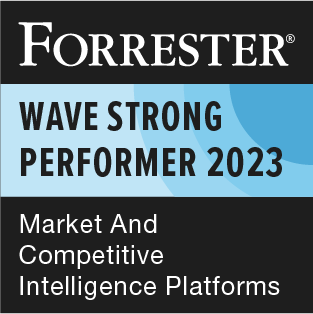People and processes are both crucial pieces of a successful competitive intelligence (CI) program. People often excel in the qualitative side of the work, with context and industry insight that no technology would possess. On the other hand, processes and technology are adept with quantitative work, with an ability to process data more quickly, in larger quantities, and more accurately. Achieving the right balance between people and process in the CI function can make all the difference in the program’s success.
In competitive intelligence, both humans and process/technology have unique strengths and value-add, which we elaborate on in the table below.
|
Strengths of People in Competitive Intelligence
|
Strengths of Process and Technology in Competitive Intelligence
|
|---|---|
|
Conducting interviews with subjects matter experts to strengthen market understanding and validate data findings.
|
Automated data collection and processing powered by AI and machine learning, enabling quick analysis of large datasets.
|
|
Connecting the dots in data and seeing the bigger picture.
|
Real-time monitoring of competition, market trends, and customer sentiment for immediate insights, which is especially useful during crises.
|
|
Spotting emerging opportunities and potential threats and suggesting strategies for market advantage and risk avoidance.
|
Adept at storing and organizing CI insights, facilitating centralized, organized views of all insights in knowledge repositories and databases.
|
|
Contextual analysis and interpretation of complex data, understanding industry nuances and culture-specific factors.
|
Efficient workflow automation for data extraction, report generation, and information dissemination, freeing up human analysts for strategic analysis.
|
As you can see from the table, both people and processes are critical to a mature, successful competitive intelligence function. So, how should you go about finding the right combination of the two? Here are 7 steps to achieve a balance between people and process.
1. Think critically about your existing process. What are your goals, and where are you falling short? Are you relying too heavily on people? Clues might be: your CI function is ad-hoc, decentralized, failing to identify important threats, or taking a while to respond to requests for information. Or are your CI efforts too reliant on technology and process? Here are some examples of situations where competitive intelligence is over-reliant on technology and process:
-
- You have abundant data, but you don’t feel that it’s supporting your decision-making and don’t know what to make of the insights generated.
- Your analysis fails to understand the industry context or capture nuance or culture-specific factors.
- You’re encountering issues with data being properly validated.
2. Identify where human analysts are most valuable. Some examples include: making recommendations to the C-suite, assessing risks and opportunities, and interpreting complex data. See how you can free up people on your CI team to do this mission-critical work. Leverage the strengths of technology and process to give people that time back.

The Ultimate Guide to a Integrating AI into Competitive Intelligence Programs
3. Automate data collection and aggregation. Make use of technology and automated processes to streamline data collection and processing tasks. Web scrapers, data crawlers, and sentiment analysis algorithms can efficiently gather and analyze large amounts of data, freeing up human analysts to do more strategic work.
4. Explain to team members why new processes and technologies are being implemented. Reassure them that it’s not meant to replace them in any way – it’s to make their work that much more powerful and scalable throughout the organization.
5. Foster a collaborative and communicative environment. Team members should share what they’re learning with each other and other departments.
6. Encourage continuous learning and development for people on the CI team. CI team members add depth to their work with industry knowledge and context, so provide them with frequent opportunities for learning and professional development.
7. Periodically review the CI function. Aim to collect feedback from team members and organization leaders on how the CI function is coming along at least once every year. Collecting feedback from within the CI team more regularly, whether quarterly or biannually, would also be beneficial. What needs improvement? How can re-balancing people vs. process improve that issue? Be open to re-adjusting and re-adjusting again based on where you see things work and where the balance isn’t quite right. Changing market and economic conditions and new technologies sometimes mean a previously ideal balance must be recalibrated.
Insightsfirst, Evalueserve’s AI-enabled competitive and market intelligence platform, can help your business achieve the perfect balance between people and process/technology.
Forrester Research Named Evalueserve's Insightsfirst a Strong Performer



